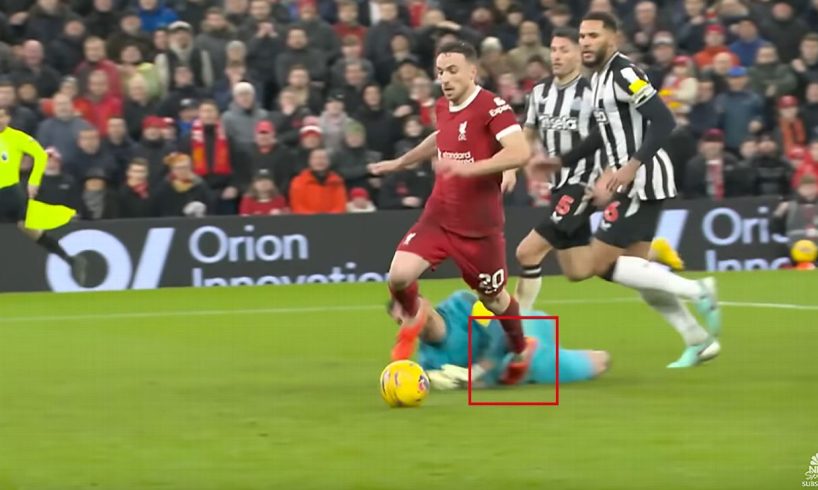
Video Assistant Referee causes controversy every week in the Premier League, but how are decisions made, and are they correct?
After each weekend we take a look at the major incidents, to examine and explain the process both in terms of VAR protocol and the Laws of the Game.
– How VAR decisions have affected every Prem club in 2023-24
– VAR in the Premier League: Ultimate guide
In this week’s VAR Review: Should Diogo Jota’s penalty for Liverpool against Newcastle United have been overturned? And is the VAR looking to support the on-field decision too much? Plus, all the incidents from the latest round of games.
Possible penalty overturn: Dúbravka challenge on Jota
What happened: Diogo Jota ran through on goal in the 84th minute, attempted to go past goalkeeper Martin Dúbravka and then went to ground. Referee Anthony Taylor pointed to the penalty spot, with the decision checked by the VAR, Stuart Attwell (watch here.)
VAR decision: Penalty stands, scored by Mohamed Salah.
Martin Dúbravka clips the right foot of Diogo Jota. NBC
VAR review: Premier League referees work under an instruction that contact must have a consequence if a spot kick is to be awarded, while the attacker should go down in a way which fits that contact.
On first viewing, it looked like Jota had simulated without contact. Yet upon watching the replays, the goalkeeper did catch the Liverpool forward’s left leg with his left arm. But does that mean this should remain a penalty with such a small amount of contact and a delayed fall?
Editor’s Picks
2 Related
Yet with the weight a referee’s decision on the field carries, and the high threshold for a VAR intervention, penalties like this don’t tend to get overturned. Any evidence of contact leads to the VAR supporting the on-field call. We saw it with spot kicks awarded against Wolves to Newcastle United and Sheffield United. In both those cases there was negligible contact, though the Premier League’s Independent Key Match Incidents Panel said the VAR should have intervened in those cases.
The VAR requires such clear evidence of an error, few spot kicks actually get cancelled. Of the five overturned this season, only one has been for a foul (the other four were for handball.)
Was this really enough to make Jota go down as he did, dragging his right foot along the ground two steps later? If Taylor hadn’t awarded a penalty it’s unlikely the VAR would have sent the referee to the monitor.
Most fans would prefer VAR gets involved in situations like this to at least let the referee have another look, though that will require a change in the ethos of VAR and a lowering of the threshold. Right now a referee only goes to the monitor to confirm he has made a “clear and obvious” error rather than to check it.
Diogo Jota hasn’t started going down even though he is already past Martin Dúbravka. Andrew Powell/Liverpool FC via Getty Images
“Clear and obvious” has been a millstone around the neck of VAR since its inception, largely because it’s so difficult to define and is the subjective view of another of the 20 referees who act as a VAR in the Premier League. It’s just a second opinion.
But removing “clear and obvious” wouldn’t be the magic wand many think it would be. It would lead to far more stoppages and wouldn’t necessarily mean different outcomes. Indeed, after the penalty awarded to Sheffield United, Wolves boss Gary O’Neil said referee Robert Jones insisted his decision was correct after watching replays postmatch. Additional reviews to a lower threshold doesn’t mean the referee will believe he’s made a mistake.
Also lost in the “clear and obvious” discussion is that there will always be an aggrieved side in these 50-50 or 60-40 situations; just ask Arsenal fans after they had a spot kick overturned against Manchester United earlier this season. (Taylor was the referee for this game, too.) Taylor gave the spot kick because he believed Aaron Wan-Bissaka had tripped Kai Havertz when he placed his right foot — but there was no contact with the Arsenal player at this point. Thus, Taylor hadn’t described the contact correctly, and it opened the door for a review.
Or when Arsenal didn’t get a penalty for a small amount of contact by Aston Villa’s Douglas Luiz on Gabriel Jesus (a decision supported by the independent panel.) There was arguably more contact than there was for Jota, yet the penalty wasn’t given on the field and it wasn’t enough for a VAR overturn. But if the ref had given it, it would have stayed a penalty. Consistency of decisions isn’t possible under this protocol, nor it is the intention.
Attwell was the referee for the debatable late penalty that gave Aston Villa victory at home to Burnley, covered later, so at least you could say he’s been consistent on the pitch and in the VAR hub.
Possible penalty overturn: Botman challenge on Diaz
What happened: Luis Díaz moved in on goal in the 20th minute, stumbling to the ground after a tackle by Sven Botman. Referee Taylor had also pointed to the spot for this earlier incident (watch here.)
VAR decision: Penalty stands, Salah shot saved by Dúbravka.
Sven Botman catches Luis Diaz. NBC
VAR review: While there might have been questions over the later penalty, there was no chance this would be overturned. There was clear contact by Botman’s right leg onto Diaz’s left, which caused him to lose his footing.
Diaz may have gone down easily, but this spot kick was far more supportable.
Possible onside: Foster when scoring
What happened: Lyle Foster thought he had given Burnley the lead in the 37th minute when he ran onto a pass from Zeki Amdouni, and coolly finished past Aston Villa goalkeeper Emiliano Martínez. The flag went up for offside after the ball hit the back of the net and the VAR checked to make sure it was correct.
VAR decision: No goal.
VAR review: This was far closer than anyone might have expected, with attacker and defender crossing just inside the Villa half to give the impression it was a clear offside. Yet as soon as the picture was frozen at the point of the pass by Amdouni, it was going to be exceptionally tight.
Indeed, there is only a very small gap between the attacking and defensive lines — and if they overlap, the “benefit of the doubt” goes to the attacker and the goal is allowed to stand.
The offside flag is delayed to let the attack play out and a goal to be awarded in the case of an incorrect decision by the assistant. Without that, goals can only be ruled out for offside through VAR and never added, as play would stop before the goal. That said, in the 4½ seasons of VAR in the Premier League only 42 goals have been awarded due to an incorrect offside, compared to 151 which have been disallowed.
It’s frustrating in some cases, but often the impression of an obvious offside turns out to be much closer.
Indeed, Manchester City boss Pep Guardiola was annoyed that a delayed offside flag led to an injury to John Stones in the 3-1 win at Everton on Wednesday.
“I don’t understand,” Guardiola said. “It’s so clear, the offside, and now he is injured. It’s not them [the officials], the rules come from the big bosses … but I don’t understand.”
Yet the offside decision against Beto was much closer than Guardiola might have thought.
The Premier League and the Bundesliga both tried out having the assistant raising the flag and play continuing when VAR was first introduced in those leagues, but that only caused confusion for the defending team.
Possible penalty and/or red card: Carlos handball
What happened: The game was in the 60th minute when Foster chased a pass down the centre. Diego Carlos was in front of the Burnley striker and after the defender attempted to control the ball on his thigh, it bounced up and hit his hand. Play continued for a few strides and Foster poked a shot wide of the post. There was a check for a possible handball offence by the Aston Villa defender.
VAR decision: No penalty or red card.
VAR review: The ball touched the hand of Carlos outside the area, so there can be no penalty. The VAR cannot advise a free kick has been missed, but he can look at a possible red card for denying an obvious goal-scoring opportunity (DOGSO).
Foster was behind the defender when the ball hit Carlos’ arm, and it was the deflection off the hand which moved it to the left to allow the striker the chance of a shot.
Foster didn’t have control of the ball, and would still have to take the ball past Carlos (if you consider where the ball would have been without it hitting the arm), so it’s not within DOGSO and the VAR, Peter Bankes, was correct not to get involved.
That said, Bankes determined the handball was inadvertent rather than a deliberate act, which it would need to be for any possible handball offence in this situation. There was a movement of the arm by Carlos, so it may have made more sense for the red card to be ruled out on the grounds of DOGSO rather than it not being handball.
Even though the VAR cannot award a free kick, play would restart with the free kick to Burnley if a DOGSO red card had been identified. Another of the many quirks of VAR protocol.
The ball hits the hand of Diego Carlos as he looks to shield it ahead of Lyle Foster. BBC
Possible penalty overturn: Ramsey foul on Durán
What happened: Aston Villa were awarded a penalty in the 86th minute when Jhon Durán went down from a challenge by Aaron Ramsey. Referee Stuart Attwell paused for a second before pointing the spot, with Bankes checking if the decision was correct.
VAR decision: Penalty stands, scored by Douglas Luiz.
VAR review: As discussed in the Liverpool-Newcastle section, the weight of the referee’s decision guiding the VAR is the over-riding factor again. Once a penalty has been given on the field for this it’s not going to get overturned.
Ramsey kicked the bottom of Durán’s boot, so the VAR cannot say the referee made a clear and obvious error in awarding the penalty.
Would the VAR have told the referee to go to the monitor if he’d not awarded it? Probably not.
Aaron Ramsey kicks the foot of Jhon Durán, making it very unlikely there would be a VAR intervention. BBC
Possible offside: Saka when scoring
What happened: Bukayo Saka gave Arsenal the lead at Fulham after just five minutes when he bundled home from close range following a Bernd Leno save from a Gabriel Martinelli shot. Saka looked a couple of yards offside, but the flag stayed down.
VAR decision: Goal stands.
VAR review: A misleading situation, with Saka having come from around the back of the Fulham defence to score the goal. The England international was being played onside by the right foot of two opposition players.
Possible penalty: Saliba foul on De Cordova-Reid
What happened: Fulham had the ball inside the penalty area in the 22nd minute. Bobby De Cordova-Reid moved in front of William Saliba as the Arsenal defender attempted to make a clearance, with the Fulham player going to ground. Referee Josh Smith ignored the claims for a penalty, and it was checked by the VAR, Paul Tierney.
VAR decision: No penalty.
VAR review: It there had been evidence of contact from the Arsenal defender, there would have been a strong case for a spot kick. If there was any, it was negligible.
And once again this provides a comparison with the situations in Liverpool vs. Newcastle. If the referee had given a penalty here would it have been overturned? Probably not.
Possible red card: Saliba foul on Wilson
What happened: Harry Wilson broke through the centre in the 86th minute looking to latch onto a pass. He was tugged back outside the area by Saliba, with referee Smith producing a yellow card. Was there a case for Saliba to be shown a red card for denying an obvious goal-scoring opportunity?
VAR decision: No red card.
Gabriel is covering when Harry Wilson is pulled back by William Saliba. BBC
VAR review: Fulham manager Marco Silva and the club’s supporters were angry that the referee only cautioned Saliba, but there was no case in law for a red card.
Gabriel was covering and ahead of Wilson, so the Fulham forward couldn’t be considered to be in a clear position to score following the foul.
Possible penalty: Handball by Toffolo
What happened: Four minutes into added time at the end of the game, a cross was played in from the left. Both Scott McTominay and Moussa Niakhaté tried to head the ball and missed, with it hitting Harry Toffolo behind them. There were claims for a penalty, which referee Tim Robinson waved away.
VAR decision: No penalty.
The ball hits the arm of Harry Toffolo in front of his body. BBC
VAR review: Toffolo had his arm in front of his body, so the only way this could be a penalty was if it were a deliberate act. Any movement of the arm appeared to be purely natural, so it was very quickly cleared by the VAR, Michael Salisbury.
Possible offside: Doughty on Adebayo goal
What happened: Luton Town had a way back into the game in the 74th minute when Elijah Adebayo headed home, but there was a VAR check for offside.
VAR decision: Goal disallowed.
VAR review: It’s an offside situation which catches supporters unaware, as Alfie Doughty was running back from a position on the left wing when he received a pass, and then swung in the cross for Adebayo to score.
It would have been a difficult one for the assistant to spot from the other side of the pitch, but it was quickly apparent from the first replay that Doughty’s trailing leg was going to be in advance of the last Chelsea defender. An easy VAR overturn.
Some parts of this article include information provided by the Premier League and PGMOL.






